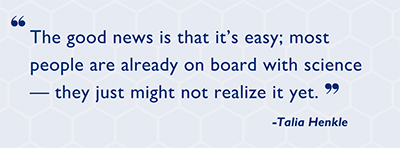Human well-being and the eradication of disease are causes that bring everyone together. Some people give back by donating their change to philanthropies at the grocery store, others participate in charity events, while some take the plunge and work in fields such as health care or research. I, like many scientists, decided to make my contribution to human well-being by going to graduate school, and have since landed in a lab studying HPV-associated cancers.
I had no doubt that my career choice would be positively regarded by anyone, regardless of their connection (or lack thereof) with science. However, one day I was completely taken aback when I saw that one of my acquaintances shared an article on Facebook about how a vaccine for HPV was a ploy used by scientists to sterilize young women, which is obviously a complete falsehood. Even worse was that the person who shared this article had been a participant in a university fundraiser for cancer. Of all the burning questions in my head at that moment, the one that stuck out most was, How is it that people can support fundraising for research and simultaneously not support the products of it (e.g., a vaccine for HPV)? Clearly the direct connection between philanthropic efforts (and the general desire to improve health) and scientists has been lost to the public. So, what do we do?
Bridging the Gap
 Things that are not well understood are often mistrusted, which, in extreme cases, can lead to articles like the one just mentioned. Since that revelation, I have realized how important it is to make biomedical scientists and their work more visible and relatable to the public. In my journey to address this issue, I have discovered several recurring misconceptions. Firstly, when most nonscientists hear that I am a “graduate student” or “Ph.D. candidate,” they often assume that all I do is study. I’ve found that most people are pleasantly surprised when they learn that biomedical Ph.D. candidates are the people who, generally, use philanthropic and government funding to try to understand and find cures for diseases, and I believe that clarification can help build credibility among scientists. Another misconception I have identified is that people feel that they aren’t capable of understanding what Ph.D. candidates actually do, which detracts from any hope of genuine enthusiasm about biomedical research. (I know many scientists make this assumption as well, which maintains the current divide.) I have found that crafting a brief and simple statement of what I do has been extremely helpful in connecting with nonscientists, even if I believe what I say to be an egregious generalization.
Things that are not well understood are often mistrusted, which, in extreme cases, can lead to articles like the one just mentioned. Since that revelation, I have realized how important it is to make biomedical scientists and their work more visible and relatable to the public. In my journey to address this issue, I have discovered several recurring misconceptions. Firstly, when most nonscientists hear that I am a “graduate student” or “Ph.D. candidate,” they often assume that all I do is study. I’ve found that most people are pleasantly surprised when they learn that biomedical Ph.D. candidates are the people who, generally, use philanthropic and government funding to try to understand and find cures for diseases, and I believe that clarification can help build credibility among scientists. Another misconception I have identified is that people feel that they aren’t capable of understanding what Ph.D. candidates actually do, which detracts from any hope of genuine enthusiasm about biomedical research. (I know many scientists make this assumption as well, which maintains the current divide.) I have found that crafting a brief and simple statement of what I do has been extremely helpful in connecting with nonscientists, even if I believe what I say to be an egregious generalization.
It’s important that people understand that scientists are everyday people who are working toward the same goals as everyone else. Making an effort to show the public that biomedical science has a friendly face and mission can help people connect to it and hopefully put an end to any negative misconceptions. The good news is that it’s easy; most people are already on board with science — they just might not realize it yet.
